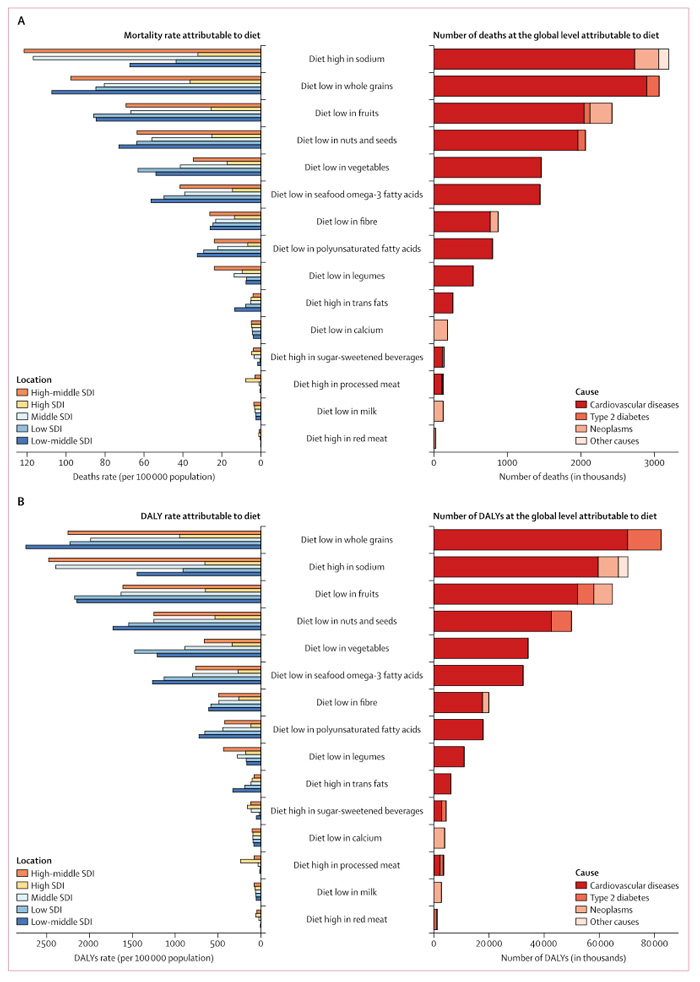
The “golden food” rules: results from The Lancet
On 3 April 2019 the Lancet published: relationship between diet and incidence of diseases
A group of medical scientists – linked together by the common goal of a study called Global Burden of Diseases, Injuries and Risk Factors (GBD) 2017 – recently published in the highly quoted scientific journal of medicine, The Lancet, the results of a huge data collection work covering 195 countries in the period 1990-2017. The study was funded by the Bill & Melinda Gates Foundation.
The aim of the study was to give a global view – therefore representative of all parts of the world – of the importance of dietary habits in the 195 countries considered for their potential impact on the incidence of disease and mortality. 15 habits have been identified, based on their transversal importance for proper nutrition and necessary in all diets.
In the 15 pages of the publication, which specialists in the field must read carefully entering in to the merits of the data, come up some news that instead all, specialists and not, must know. In fact, we all need to know and reflect on the 15 eating habits that have shown a significant connection for the incidence of death and disability from diseases affecting our society, including cardiovascular diseases, cancers and type 2 diabetes.
These 15 habits in fact establish the “golden rules” to be followed, in all countries of the world, regardless of the type of local food.
What are the 15 daily habits examined as a risk factor for death or disability?
- DIET LOW IN FRUITS; optimal range of intake: 200-300g per day
- DIET LOW IN VEGETABLES; optimal range of intake: 290-430 g per day
- DIET LOW IN LEGUMES; optimal range of intake: 50-70 g per day
- DIET LOW IN WHOLE GRAINS for any type of preparation (bread, pasta, cakes) and type of food (rice, cereals); optimal range of intake: 100-150 g per day
- DIET LOW IN NUT AND SEED FOODS; optimal range of intake: 16-25 g per day
- DIET LOW IN MILK (including all types of milk, excluding all vegetable derivatives); optimal range of intake: 350-520 g per day
- DIET HIGH IN RED MEAT (including beef, pork, lamb, and goat, but excluding poultry, fish and eggs); optimal range of intake: 18-27 g per day
- DIET HIGH IN PROCESSED MEAT (preserved by smoking, curing, salting, or addition of chemical preservatives); optimal range of intake: 0-4 g per day
- DIET HIGH IN SUGAR-SWEETENED BEVERAGES (including carbonated beverages, sodas, energy drinks, fruit drinks, but excluding 100% fruit and vegetable juices); optimal range of intake: no more than 50 g per day
- DIET LOW FIBER (intake of foods containing fiber including fruits, vegetables, seeds, legumes and pulses); optimal range of intake: 19-28 g per day
- DIET LOW IN CALCIUM (intake of foods containing calcium, including milk, yogurt, and cheese); optimal range of intake: 1-1.5 g per day
- DIET LOW IN OMEGA-3 FATTY ACID (especially EPA and DHA); optimal range of intake: 200-300 mg per day
- DIET LOW IN POLYUNSATURATED FATTY ACIDS (intake of omega-6 from all sources, especially vegetable oils, including soybean oil, corn oil and sunflower oil); optimal range of intake: 9-13 g per day.
- DIET HIGH IN TRANS FATTY ACIDS (from all sources, mainly partially hydrogenated vegetable oils and ruminant products): no more than 0-1% of the total daily energy coming from food (note that 1 g of fat gives 9 calories and the energy requirement varies with age and state of the person between 1600-2000 calories)
- DIET HIGH IN SODIUM (based on 24-hour urinary sodium measured in g per day); optimal range of intake: 1-5 g per day
The sad podium among the 15 habits as a cause of death is divided between: 1) diet high in sodium; 2) diet low in whole grains; 3) diet low in fruits, and as a cause of disease we always find the first two with places exchanged between them. The habits of eating dried fruit and seeds, vegetables and omega-3 are also recognized as fundamental. But, of course, all habits are equally important in directing global improvement, for a more favorable state of health (Figure 3 of the article).
Mortality cases and impact on diseases in the World
Italy results with a favorable relationship between the low incidence of death/disease and the habits described above, being in the penultimate band for frequency of death and in the last band for frequency of disease, namely: 105-142 deaths and less than 2339 events of disease per 100 thousand inhabitants that have as a determining cause the errors of these habits. The incidence of dietary habits in the state of health of the population reaches the highest levels in other countries, such as Russia and China, but also Egypt and Libya, surpassing as a cause of death 397 cases and as a cause of disease 8740 cases per 100 thousand inhabitants. There are socio-economic reasons that must be taken into account, but in general this situation is considered as the evident failure of public health policies, at a global level, country more country less.
Fat intake and the importance of lipidomics
With our lipidomic vision it is quite relevant to observe that 4 out of 15 causes concern our beloved fats: diets low in omega-3 and in polyunsaturated fatty acids levels, high in trans-fatty acids or low in dried fruit and seeds. Saturated fats are not even mentioned, confirming that our interest must be directed mainly to the fatty acids that we SHOULD take from food, i.e. the sources of essential fatty acids OMEGA-6 and OMEGA-3. Do we take enough of them and reach the tissues in which they have vital functions?
This question is answered by the cell membranes lipidomic analysis, which becomes the analysis most directly related to dietary habits, to detect errors and correct them in time, making a real active prevention. That is the reason why the analysis must be performed with methods free from manual inaccuracies, i.e. with robotic procedures specialized in separating the cell membrane, also identifying the mature red blood cell as the optimal reporter of the personalized condition.
The data of this publication represent a warning from science to society, pushing all countries and their policies to apply scientific progress to really increase global welfare, overcoming the challenge of improving the health of all, no one excluded.
Edited by the Lipinutragen Editorial Board
made up of F. Bonucci (nutritionist biologist), C. Ferreri (CNR Senior Researcher) and R. Rinaldi (Marketing Manager)
- On 10 May 2019






